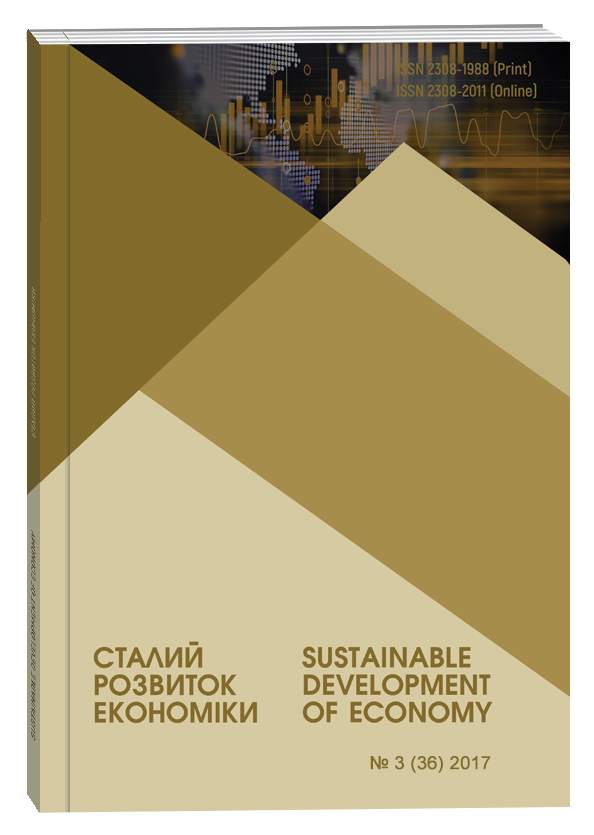THE STRATEGY OF “SURVIVAL” IS THE BASIS OF THE FUNCTIONING OF PERSONAL PEASANT FARMS
Abstract
Purpose. The aim of the article is the development of theoretical, methodological provisions on the substantiation of the strategy of “survival” as the basis of the functioning of personal peasant farms. Methodology of research. General scientific and special methods were used in the course of the research, in particular: the method of theoretical generalization was applied in carrying out a critical analysis of the results of researches of domestic and foreign scientists regarding the substantiation of the strategy of “survival”; the monographic method is used in summarizing the results of the research of the activity of personal peasant farms. Findings. The methodological basis of the functioning of private peasant farms in the agrarian sector of Ukraine is substantiated, which is based on the strategy of “sustainability” for the majority of PPF, based on the use of the simplest means of labor, manual labor of household members and the production of organic products for the primary consideration in safe food products. Scientific novelty. The strategy of “sustainability” of the category “personal peasant farm” in Ukraine is substantiated, which is based on the need to meet the vital needs of members of their household and their families, regardless of the level of economic efficiency of production, the use of simple means of production, manual labor, multi- sectoral activities, which largely dampen negative influence of destructive phenomena in the country’s social and economic development (inflation processes, price disparity, lack of proper state support, etc.). Practical value. It is established that the main features of economic behavior of rural households include: transformation from a subsidiary into the main source of income and, at the same time, agricultural production for survival; PPF is a significant factor in the employment of the rural population; providing a significant impact on the functioning of the agricultural sector of the country; dependence of development of households on infrastructure development; direct dependence on the state of the economy as a whole, as well as state policy in the field of finance and credit, taxes, prices, foreign trade activities, etc.
References
Чаянов А.В. Крестьянское хазяйство / Чаянов А.В. – М. : Экономика, 1989. – 492 с.
Особисті селянські господарства: стан та перспективи розвитку (Регіональні дослідження) : монографія / Пітюлич М. І. та ін. ; за заг. ред. д-ра екон. наук, проф. Пітюлича М. І. ; Мукачів. держ. ун- т, Закарпат. регіон. центр соц.-екон. і гуманітар. дослідж. НАН України. – Мукачево : Вид-во МДУ, 2016. – 154 с.
Meiners J.E., Household, Paid, and Unpaid Work Time of Farm Women / Meiners J.E., Olson G.I. // Family Relations. – 1987. – Vol. 36. – No. 4. – Р. 407–411.
Самсонов В.Б. Самоорганизация сельского хозяйства / В.Б. Самсонов, В.Л. Шабанов // Социологические исследования. – 1999. – № 3. – С. 46-51.
Трансформація особистих господарств населення у стратегії удосконалення соціально- економічного розвитку аграрної сфери економіки : монографія / О.О. Непочатенко, В.А. Слєпцов, М.М. Ігнатенко, К.А. Пилипенко; Уман. нац. ун-т садівництва. – Умань : Укрпромторгсервіс, 2013. – 245 c.
Чаянов А.В. Основные идеи и формы организации сельскохозяйственной кооперации / Чаянов А.В. – М. : Наука, 1991. –454 с.
Kalchenko S.V. Current development prospects of farm households / S.V. Kalchenko // Актуальні проблеми економіки. – 2013. – № 12. – С. 147-152.
Фадеева О. Типология семейных стратегии / О. Фадеева // Рефлексивное крестьяноведение: Десятилетие исследований сельской России : монография / под ред. Т. Шанина, А. Никулина, В. Данилова. – М. : МВШСЭН, РОССПЭН, 2002. – С. 215-226.
Шпичак О.М. Реалізація продукції особистими селянськими господарствами – витрати, ціни, ефективність / О.М. Шпичак, І.В. Свиноус. – К. : ІАЕ, 2008. – 320 с.
Шанин Т. Определяя крестьянство / Т. Шанин // Отечественная история. – 1993. – № 2. – С. 7–16.
Chayanov, A.V. (1989), Krestyanskoye khozyaystvo [Peasant farming], Ekonomika, Moscow, Russia, 492 p.
Pitiulych, M.I. et al. (2016), Osobysti selianski hospodarstva: stan ta perspektyvy rozvytku (Rehionalni doslidzhennia) [Personal peasant farms: status and prospects of development (Regional research)], monograph, Mukachiv. derzh. un-t, Zakarpat. rehion. tsentr sots.-ekon. i humanitar. doslidzh. NAN Ukrainy, Vyd-vo MDU, Mukachevo, Ukraine, 154 p.
Meiners, J.E. and Olson, G.I. (1987), “Household, Paid, and Unpaid Work Time of Farm Women”, Family Relations, Vol. 36, no. 4, pp. 407–411.
Samsonov V.B. and Shabanov V.L. (1999), “Self-organization of agriculture”, Sotsiologicheskiye issledovaniya, no. 3, pp. 46-51.
Nepochatenko, O.O., Slieptsov, V.A., Ihnatenko, M.M. and Pylypenko, K.A. (2013), Transformatsiia osobystykh hospodarstv naselennia u stratehii udoskonalennia sotsialno-ekonomichnoho rozvytku ahrarnoi sfery ekonomiky [Transformation of individual farms in the strategy of improving the socio-economic development of agricultural sector of the economy], monograph, Uman. nats. un-t sadivnytstva, Ukrpromtorhservis, Uman, Ukraine, 245 c.
Chayanov, A.V. (1991), Osnovnyye idei i formy organizatsii selskokhozyaystvennoy kooperatsii [The main ideas and forms of organization of agricultural cooperation], Nauka, Moscow, Russia, 454 p.
Kalchenko, S.V. (2013), “Current development prospects of farm households”, Aktualni problemy ekonomiky, no. 12, pp. 147-152.
Fadeyeva, O. (2002), Tipologiya semeynykh strategiy [Typology of family strategies], Refleksivnoye krestyanovedeniye: Desyatiletiye issledovaniy selskoy Rossii - Reflexive peasant studies: A Decade of Studies in Rural Russia, monograph, eds. T. Shanin, A. Nikulin, V. Danilov, MVSHSEN, ROSSPEN, Moscow, Russia, pp. 215-226.
Shpychak, O.M. and Svynous, I.V. (2008), Realizatsiia produktsii osobystymy selianskymy hospodarstvamy – vytraty, tsiny, efektyvnist [Realization of production of personal peasant farms - costs, prices, efficiency], Kyiv, Ukraine, IAE, 320 p.
Shanin, T. (1993), “Defining Peasants”, Otechestvennaya istoriya, no. 2, pp. 7–16.


